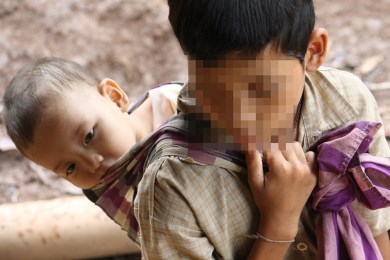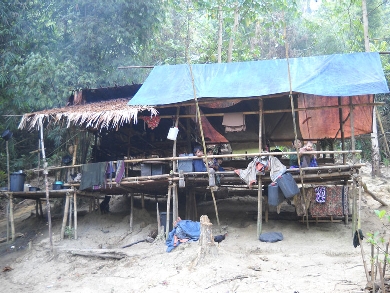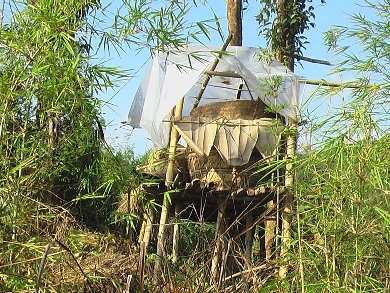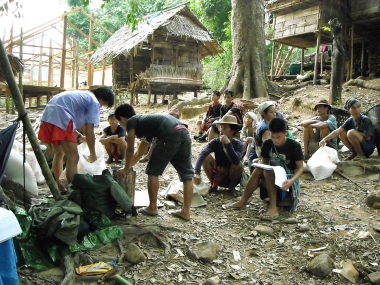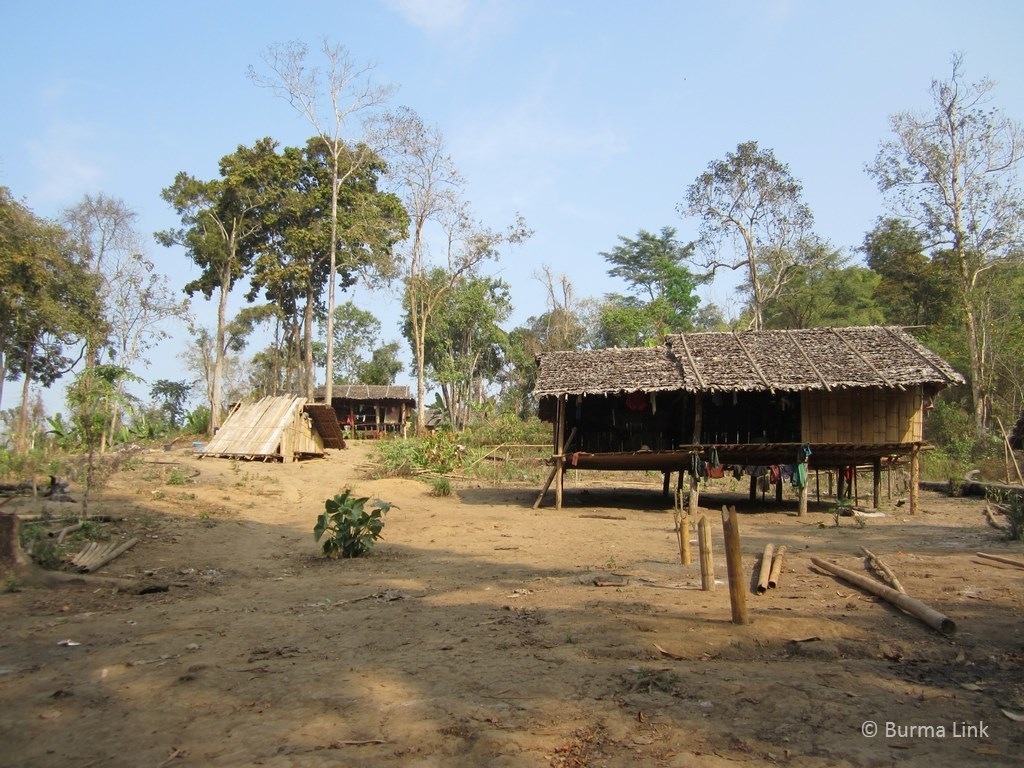“Even though we are not safe here, I don’t want to leave and stay in a refugee camp. I just want to live in my village.” (Karenni male, KSWDC focus group, Pasaung Township, June 2008; TBC, 2008, p. 11)
Accurate figures for IDPs are difficult to determine due to poor access to affected areas. The UNHCR estimates that there are 587,000 IDPs in Burma (UNHCR, 2015b), however the IDMC estimates that there were 643,000 IDPs due to conflict and violence in Burma as of July 2014 (IDMC, 2014a). According to both IDMC (2014a) and TBC (2013e), an estimated 400,000 of the internally displaced reside in southeast Burma. Only a fraction of them, 12,455 in February 2015, live in IDP camps (TBC, February, 2015). Vast majority have to manage without any protection or aid apart from help from some small local ethnic organisations that mostly operate from across the border from Thailand.
The historical ceasefire agreement signed between the KNU and the government in January 2012 filled many villagers and IDPs with hope that the generations-old conflict might finally come to an end. Largely due to this, approximately 37,000 formerly displaced persons attempted to either return to their villages or resettle in surrounding areas of southeast Burma between August 2011 and July 2012 (TBC, 2012c). During the same period, however, over 10,000 people were still forced from their homes, according to the same TBC report. More recently, the movement has slowed down; during the twelve months prior to July 2014, over 9,900 IDPs were identified as having return into their former villages or resettled elsewhere, whilst 4,200 were newly displaced (TBC, 2014c).
Most IDPs in eastern Burma have been forced to flee their homes due to the same reasons as refugees; armed conflicts between ethnic armed groups and government forces and the grave human rights violations and war crimes committed primarily by the Burma Army (for more information, see Human Rights Violations). Particularly in the ethnic outlying areas adjacent to Thailand, Burma Army has undertaken massive counter-insurgency campaigns in line with their Four Cuts policy, deliberately targeting ethnic civilians and resulting in systematic and widespread abuse and the destruction of thousands of communities. Since 1996, more than 3,700 villages have been documented as destroyed, forcibly relocated, or abandoned (TBC, 2012c). Many have argued that the actions of the Burmese army in the ethnic states count as genocide (see e.g. La Guardia, June, 2005; Rogers, 2004). Meanwhile, the Burmese military has continuously denied that its soldiers have abused civilians (e.g. RFA, March 2013b).
While ceasefires between some notable ethnic armies and the government have resulted in less direct attacks on civilians in eastern Burma in recent years (TBC, 2013a), reports indicate that violations of international humanitarian law have persisted throughout the country since the Thein Sein administration took office in March 2011 (e.g. Davis et al., 2012; ND-Burma, 2012c, 2013b, 2014a, 2014b). The KHRG report published in March 2013 indicates that natural resource extraction and business projects have fuelled human rights violations even after the ceasefire was signed between the government and the KNU (KHRG, 2013a). According to the TBC report from November 2014, “Land confiscation is linked to the consolidation of garrisons, road construction and the establishment of new concessions for mining, logging and commercial agriculture (TBC, 2014c).”
Skirmishes have not stopped either, primarily due to the lack of Burma Army troop withdrawals from sensitive areas. Although villagers in the Karen State can now travel more freely, land grabbing and drug trade has increased, and Burma Army has been fortifying their positions in Karen areas (KHRG, 2014a), bringing to question their commitment to peace. It seems that while the government is talking peace, their troops are preparing for war. Continuing Burma Army attacks and large scale offensives in northern Burma also shed doubt on the peace process. In Kachin and Shan States, Burma Army continues to abuse ethnic civilians much in the same way as they did in eastern Burma before. As long as the conflict and abuse continues anywhere in the country, and the political goals of the ethnic nationalities are not discussed, it is only a matter of time until conflict reignites in eastern Burma. The latest conflicts in the Karen State forcing thousands to flee their homes took place as recently as in September and October 2014, showing the fragility of the ceasefires.
Many ethnic civilians and the ethnic armed groups were hopeful and positive about the peace process and reforms in Burma until recently. Tensions have risen as it has begun to dawn on the people that the government may not be genuine in their efforts to build peace and a federal union. The living conditions in the ethnic borderlands in eastern Burma also remain as dire as ever, despite marked improvements in majority Burman central areas of Burma, particularly cities like Rangoon and Mandalay. TBC’s comprehensive IDP survey in 2012 found that more than half of the people in the rural communities of southeast Burma were impoverished, most of them lacked access to safe drinking water, and a third of children between five and twelve years of age were not regularly attending school (TBC, 2012c). A less comprehensive survey conducted in 2013 suggested similar results (TBC, 2013e).
The United Nations “Guiding Principles on Internal Displacement” provides authoritative standards for the obligations of governments to IDPs. Under the principles, the authorities are to provide displaced people at a minimum with safe access to essential food and potable water, basic shelter and housing, appropriate clothing, and essential medical services and sanitation (Principal 18: UN OCHA, 2004, pp. 9-10). IDPs in Burma, however, have little access to any of these (US State Department, 2013). Displacement in Burma has also been linked to poverty and poor health outcomes, including increased malaria prevalence, child malnutrition and child mortality (The Human Rights Center & The Center for Public Health and Human Rights, 2007).
While UNHCR assisted some 312,000 IDPs inside Burma in January (UNHCR, 2015b), hundreds of thousands of others live in the mountains and the jungle under desperate circumstances, often moving from one hiding site to another, collecting leaves, roots and anything they can find in order to survive. Although decades of fleeing and displacement have resulted in many communities developing creative strategies to cope with the situation, humanitarian needs of IDPs include food and other necessities, such as medicine, blankets, warm clothing, firewood and fuel, and adequate shelter. A range of civil society actors, especially local CBOs and ethnic organisations such as the Karen Office of Relief and Development (KORD) and Karen National Union (KNU), have worked to deliver aid to IDPs.
Most of these organisations are based in Thailand, from where they have arranged cross-border aid to some of the poorest and most oppressed areas in Burma. Cross-border delivery of aid has been essential for IDP survival for over 20 years, and due to the proximity of many IDPs to Thailand, combined with the difficulty of reaching them from inside Burma, it will continue to be relevant in the future. While there has been a recent relaxation of government restrictions on access into some conflict-affected areas in southeast Burma (TBC, 2012c), most communities remain out of reach from inside. Recent funding cuts on the border have, regrettably, forced many organisations such as the KORD to cut back on crucial assistance to IDPs (Saw Yan Naing, May, 2012). (For more information on recent funding cuts on the border, see Funding cuts on the border).
Since the reforms started in 2011, there has been renewed optimism that the recent developments could bring about an end to the armed conflicts between the government and a number of ethnic armed groups.
“We have great hopes for peace but we still have doubts about the process. We can’t trust the ceasefire agreement 100%, but only about 50%. If the ceasefire can be sustained, people’s livelihoods will become more stable. There hasn’t been much change in the short period so far, but at least we can say that we are more confident.” (Karenni Woman, Phruso Township, June 2012, KSWDC interview; TBC, 2012c, p. 18)
Recent stalling or even backtracking of the reform process and lack of genuine political dialogue is, however, increasingly burying the dreams for genuine peace in the near future. For sustainable peace to become reality, ceasefires will need to move to genuine political dialogue, and the deep-seated mistrust that the displaced people of Burma have developed towards the government and its military will need to be addressed. The government of Burma must acknowledge that torture and other violations are taking place, take steps to end these practices, address the complex needs of survivors, and end impunity. Acknowledging victims and survivors of past abuses will be a key for national reconciliation.
“If this peace agreement breaks down, our life will be worse than before. In our history, we have been cheated by the Burmans many times. We do not trust them, and the Burmans do not trust us. Our ancestors said that when we eat fruit from a fig tree, we should also listen for arrows. We have to be cautious.” (Karen man, Dawei Township, June 2012, CIDKP focus group discussion; TBC, 2012c, p. 12)
“I don’t dare to go back to my original village or to rebuild in a new village yet. In 2004 when KNU and the Government established a gentlemen’s agreement, I started cultivating a hillside paddy field close to the road. But the agreement broke down and I had to run deeper into the forest again. So I don’t know if I can trust the Tatmadaw this time.” (Karen Man, Hpapun Township, May 2012, KORD focus group discussion; TBC, 2012c, p. 40)
As Burma has undergone a number of changes during the past years, there are now hopes that conditions might be developed into such that IDPs and refugees may at last be able to go home. Meanwhile, it is imperative that the humanitarian needs of hundreds of thousands of IDPs are not forgotten, and movement back to the displaced persons’ former villages is not encouraged until there is genuine and lasting peace.
Updated April 29, 2015
Continue to Recent Developments

